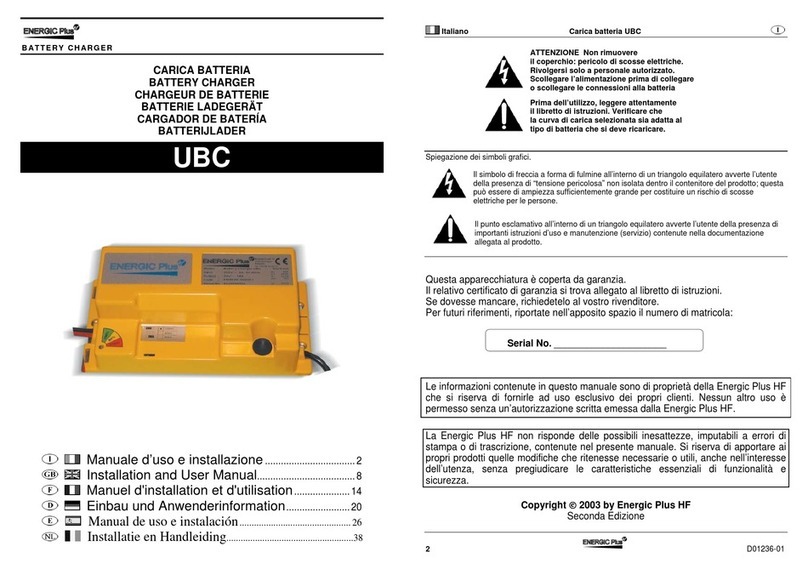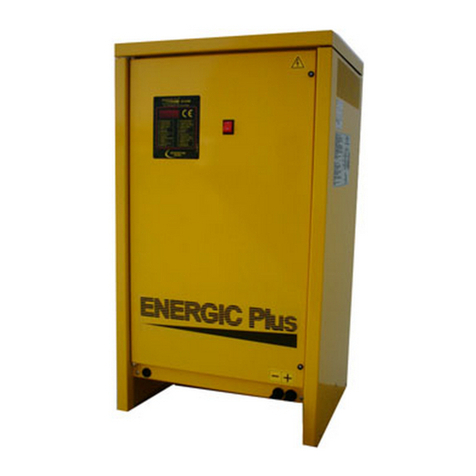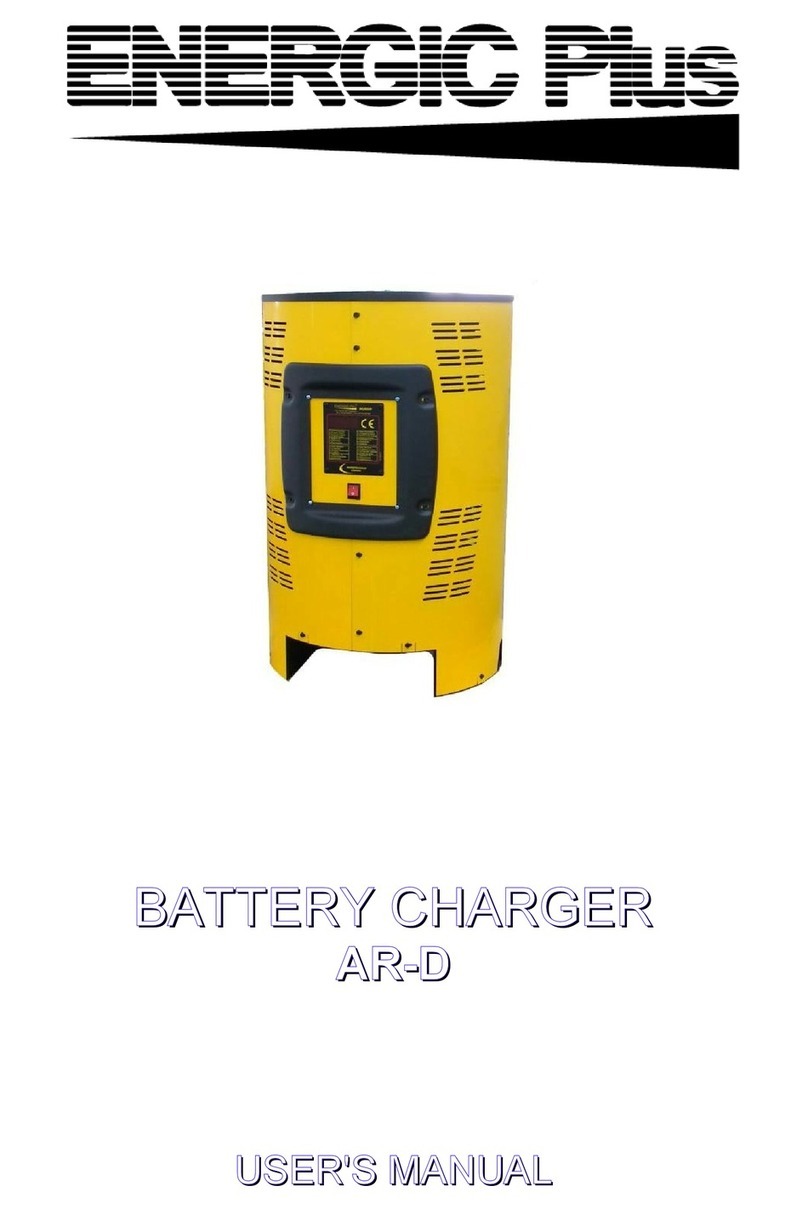Energic Plus RE Series User manual

BATTERY CHARGER
BATTERY CHARGER
RE
RE
USER'S MANUAL
USER'S MANUAL

(THIS PAGE WAS INTENTIONALLY LEFT BLANK)

Table of Contents
· 1 Introduction 4
· RESPONSIBILITY DISCLAIMER........................................................................ 4
· 2 Safety instructions and warnings 5
· GENERAL........................................................................................................... 5
· SHOCK PREVENTION........................................................................................ 5
· BURN AND BODILY INJURY PREVENTION...................................................... 6
· FIRE AND EXPLOSION PREVENTION.............................................................. 6
· MEDICAL AND FIRST AID TREATMENT........................................................... 6
· EQUIPMENT WARNING LABELS......................................................................
· 3 Description 7
· 4 Installation 8
· INTERNAL VIEW OF THE CHARGER, CABINET S.......................................... 9
· INTERNAL VIEW OF THE CHARGER, CABINET A........................................ 10
· INTERNAL VIEW OF THE CHARGER, CABINET B........................................ 10
· INTERNAL VIEW OF THE CHARGER, CABINET C........................................ 11
· AC INPUT VOLTAGE ADJUSTMENT – CABINETS S, A, B............................ 12
· AC INPUT VOLTAGE ADJUSTMENT – CABINET C........................................13
· 5 How to use the charger [Cabinets S, A, B] 14
· START OF CHARGE........................................................................................ 15
· CHARGE CYCLE.............................................................................................. 15
· 6 How to use the charger [Cabinet C] 16
· START OF CHARGE........................................................................................ 1
· CHARGE CYCLE.............................................................................................. 1
· 7 Trouble Shooting Guide 18
· 8 Spare Parts List 23
· 9 Cabinet table 24

Battery Charger RE
User's Manual
1 Introduction
This manual contains instructions and suggestions for the users of Energic plus RE battery chargers
Before to install, use or repair the charger, it's necessary to read and understand this manual
completely
It’s recommended to keep the manual in good condition for all the lifetime of the charger It should be
kept in a dry and clean place, always available to the users
Throughout this manual, the following special annotations have been used to indicate important
information
RESPONSIBILITY DISCLAIMER
The manufacturer of the Energic plus RE battery charger will not be responsible for damages and/or
injuries caused by the charger in these situations:
•The charger is not installed properly by a qualified electrician;
•Maintenance operations are not done by a qualified electrician;
•The charger is not used according to the instructions included in this manual;
•The charger is not connected to the correct input supply (see data label on the box);
•The battery is damaged during the charge;
•The charger has been modified without the authorization of the manufacturer;
•Non-original spare parts are used in the charger;
•Wrong spare parts are used in the charger
OWM-040906-RE Version: 02-AB Page 4 of 24
WARNING !
Gives important information regarding
possible personal injury
CAUTION !
Gives important information regarding
possible equipment damage
NOTE
Gives additional information and tips concerning
important procedures and features of the charger

Battery Charger RE
User's Manual
2. Safet instructions and warnings
GENERAL
Battery chargers can cause injury or death, or damage to other equipment or property, if the user does
not strictly observe all safety rules and take precautionary actions
Safe practices must be learned through study and training before using this equipment
Only qualified personnel should install, use, or service this battery charger
SHOCK PREVENTION
Bare conductors, or terminals in the output circuit, or ungrounded, electrically-live equipments can
fatally shock a person To protect against shock, have competent electrician verify that the equipment
is adequately grounded and learn what terminals and parts are electrically HOT
The body’s electrical resistance is decreased when wet, permitting dangerous current to flow through
the body Do not work in damp area without being extremely careful Stand on dry rubber mat or dry
wood and use insulating gloves when dampness or sweat cannot be avoided Keep clothing dry
INSTALLATION AND GROUNDING – Electrical equipment must be installed and mantained in
accordance with all the applicable national and local codes
A power disconnect switch must be located at the equipment Check the data label for voltage and
phase requirements If only 3-phase power is available, connect single-phase equipment to ONLY
TWO WIRES of the 3-phase line
DO NOT CONNECT the equipment grounding conductor to the third live wire of the 3-phase line as
this makes the equipment frame electrically HOT, which can cause a fatal shock
If a grounding conductor is part of the power supply cable, be sure to connect it to a properly
grounded switch box or building ground If not part of the supply cable, use a separate grounding
conductor Don’t remove a ground prong from any plug Use correct mating receptacles Check
ground for electrical continuity before using equipment
The grounding conductor must be of a size equal to or larger than the size recommended by Code or
this manual
CHARGING LEADS – Inspect leads often for damage to the insulation Replace or repair cracked or
worn leads immediately Use leads having sufficient capacity to carry the operating current without
overheating
Never extend the charging leads without prior approval of the manufacturer Extending the charging
leads without prior approval of the manufacturer may cause wrong operation of the charger and voids
the warranty
BATTERY TERMINALS – Do not touch battery terminals while equipment is operating
SERVICE AND MAINTENANCE – Shut OFF all power at the disconnect switch or line breaker BEFORE
inspecting, adjusting, or servicing the equipment Lock switch OPEN (or remove line fuses) so that
the power cannot be turned ON accidentally
Disconnect power to equipment if it is to be left unattended or out of service
Disconnect battery from charger
Measure voltage on capacitors and, if there is any voltage reading, wait 5 minutes before to proceed
Keep inside parts clean and dry Dirt and/or moisture can cause insulation failure This failure can
result in high voltage at the charger output
OWM-040906-RE Version: 02-AB Page 5 of 24

Battery Charger RE
User's Manual
BURN AND BODILY INJURY PREVENTION
The battery produces very high currents when short circuited, and will burn the skin severely if in
contact with any metal conductor that is carrying this current
Do not permit rings on fingers to come in contact with battery terminals or the cell connectors on top
of the battery
Battery acid is very corrosive Alwais wear correct eye and body protection when near batteries
FIRE AND EXPLOSION PREVENTION
When batteries are being recharged, they generate hydrogen gas that is explosive in certain
concentrations in air (the flammability or explosive limits are 4 1% to 72% hydrogen in air) The spark-
retarding vents help slow the rate of release of hydrogen, but the escaping hydrogen may form an
explosive atmosphere around the battery if ventilation is poor
The ventilation system should be designed to provide an adequate amount of fresh air for the number
of batteries being charged This is essential to prevent an explosion
Always keep sparks, flames, burning cigarettes, and other sources of ignition away from the battery
recharging area Do not break "live" circuits at the terminals of batteries Do not lay tools or anything
that is metallic on top of any battery
To prevent arcing and burning of the connector contacts, be sure the charger is OFF before
connecting or disconnecting the battery The digital display must be completely OFF
MEDICAL AND FIRST AID TREATMENT
First aid facilities and a qualified first aid person should be available for each shift for immediate
treatment of electrical shock victims
EMERGENCY FIRST AID: Call phisician and ambulance immediately and use First Aid techniques
recommended by the American Red Cross
In case of acid in the eyes, flush very well with clean water and obtain professional medical attention
immediately
EQUIPMENT WARNING LABELS
Inspect all precautionary labels on the equipment
Order and replace all labels that cannot be easily read
OWM-040906-RE Version: 02-AB Page 6 of 24
DANGER: ELECTRICAL SHOCK CAN BE FATAL
If person is unconscious and electric shock is suspected, do not touch person if he or she is in
contact with charging equipment, battery, charging leads, or other live electrical parts
Disconnect power at wall switch and then use First Aid
Dry wood, wooden broom, and other insulating material can be used to move cables, if
necessary, away from person
IF BREATHING IS DIFFICULT, give oxygen
IF NOT BREATHING, BEGIN ARTIFICIAL BREATHING, such as mouth-to-mouth
IF PULSE IS ABSENT, BEGIN ARTIFICIAL CIRCULATION, such as external heart massage

Battery Charger RE
User's Manual
3. Description
Energic plus RE battery chargers have been designed to charge Pb batteries
These units convert the AC input voltage to a DC voltage at the correct level, in order to charge the
battery cells
These battery chargers are fully automatic, and they are controlled by a microprocessor based
electronic board
The entire charge sequence is monitored by the microprocessor, that is programmed to manage all
the possible operating conditions:
•Automatic start on battery connection, with 5 seconds delay to avoid sparks between the
connectors;
•Automatic shutdown on battery disconnection;
•Adaptive algorithm for charge time calculation;
•Wrong battery detection;
•Automatic weekly equalization charge;
•Two emergency timers for battery protection
STANDARD CHARGERS [Wa]
The charge current follows the Wa curve, as
defined by the Standard DIN 41774
After some hours, depending by the conditions
of the battery, when the battery’s voltage
reaches the “gassing” value (2,4 Volt per cell),
the LED “FINAL CHARGE” starts to flash and
the charge continues
FAST CHARGERS [WoWa]
The charge current follows the WoWa curve, as
described by the Standard DIN 41773
The reduction of the charge time is achieved by
applying a higher current during the first period
of charge When the "gassing" voltage is
reached, the current value is reduced to avoid
overheats in the battery, and the charge
continues in the same way of standard Wa
models
OWM-040906-RE Version: 02-AB Page 7 of 24

Battery Charger RE
User's Manual
4. Installation
The charger is marked with a technical label, containing the following data:
•Model;
•Serial number (S/N);
•Weight (kg);
•Input voltages (V);
•Maximum input current (A);
•Maximum input power (KVA);
•Input frequency (Hz);
•Battery voltage (V);
•Maximum output current (A)
Conditions of use:
•Operating temperature: 5°C to 45°C
•Storage temperature: -20°C to 60°C
•Relative humidity: less than 75%
OWM-040906-RE Version: 02-AB Page 8 of 24
CAUTION !
The charger can be installed by qualified personnel only
NOTE
This unit operates on 220-230-240 V AC, 50Hz
Check that the unit's operating voltage is identical to your local power supply
Check that the unit's maximum input power is available from your power supply
CAUTION !
To prevent fire or shock hazard, do not expose the unit to rain or moisture
Do not use the unit in presence of flammable gas, because it can be generate sparks

Battery Charger RE
User's Manual
INTERNAL VIEW OF THE CHARGER – CABINET S
OWM-040906-RE Version: 02-AB Page 9 of 24
CAUTION !
Allow adeguate air circolation to prevent internal heat buildup
Do not place the unit near materials that may block the ventilation slots
Do not install the unit near heat sources such as radiators or air ducts, or in a place
subject to direct sunlight, excessive dust, mechanical vibration or shock
CAUTION !
To avoid electrical shock, do not open the cabinet
Refer servicing to qualified personnel only
NOTE
Check the efficiency of earth circuitry (yellow/green cable);
Connect the charger to the mains using an adeguate plug, with pushbutton and fuses;
Use an adeguate plug to connect the charger to the battery

Battery Charger RE
User's Manual
INTERNAL VIEW OF THE CHARGER – CABINET A
INTERNAL VIEW OF THE CHARGER – CABINET B
OWM-040906-RE Version: 02-AB Page 10 of 24

Battery Charger RE
User's Manual
INTERNAL VIEW OF THE CHARGER – CABINET C
ELECTRICAL INSTALLATION OF THE CHARGER
•Check the efficiency of earth circuitry (yellow/green wire);
•Connect the charger to the mains using an adeguate plugs, with pushbutton and fuses;
•Use an adeguate plug to connect the charger to the battery
OWM-040906-RE Version: 02-AB Page 11 of 24

Battery Charger RE
User's Manual
AC INPUT VOLTAGE ADJUSTMENT – CABINETS S, A, B
PROCEDURE:
•Disconnect the charger from main supply and
battery;
•Open the cabinet;
•Locate the terminal block for AC input voltage
setting;
•Disconnect the wire A from the original
terminal block (position 2);
•Connect the wire A to the desidered position
[Check the table to find the correct position];
•Close the cabinet;
•Connect the charger to main supply
OWM-040906-RE Version: 02-AB Page 12 of 24
CAUTION !
These settings can be done by qualified personnel only
For more information please contact the manifacturer

Battery Charger RE
User's Manual
AC INPUT VOLTAGE ADJUSTMENT – CABINET C
PROCEDURE:
•Disconnect the charger from main supply and
battery;
•Open the cabinet;
•Find the termial blocks for AC input voltage setting;
•Disconnect the wire A from the original terminal
block (position 2);
•Connect the wire A to the desidered position
[Check the table to find the correct position];
•Close the cabinet;
•Connect the charger to main supply
OWM-040906-RE Version: 02-AB Page 13 of 24
CAUTION !
These settings can be done by qualified personnel only
For more information please contact the manifacturer

Battery Charger RE
User's Manual
5. How to use the charger [Cabinets S, A, B]
PRELIMINARY CONTROLS
•Inspect the charger completey for loose screws, electrical connections or other damages;
•Check that all the ventilation slots are not obstructed to assure proper air flow;
•Make sure that the charger is installed as instructed in this manual and in accordance with any
applicable national or local norm
LED CONTROL PANEL
OWM-040906-RE Version: 02-AB Page 14 of 24
WARNING !
ENERGIC Plus RE chargers are programmed to do a complete cycle of charge,
however it’s recommended to survey the operations when the battery must remain
connected to the charger for more than 12 hours (example: week-ends)

Battery Charger RE
User's Manual
START OF CHARGE
The charger turns on automatically when the battery is correctly connected, with a delay of 5 seconds,
in order to avoid sparks between the connectiors
If the main supply is not present, all the control LEDs (except the “BATTERY CONNECTION” LED)
blink alternately
CHARGE CYCLE
The current of charge follows the Wa curve During the first charge period, while the battery voltage is
below the gassing value, the LED “CHARGE ON” blinks continuously
After some hours, depending by the conditions of the battery, when the battery’s voltage reaches
gassing value, the LED “FINAL CHARGE” starts to blink and the charge continues
The electronic control of the charger measures only the time of effective charge so, even after one or
more main supply black-outs, the charge cycle re-starts from the point of interruption The electronic
control is reset only when the battery is disconnected
After the finishing charge time (~3 hours) the charge is completed, and the LED “STOP-100%” turns
on At this point the equalization cycle starts
If the charge is not normally completed within 12 hours, the electronic control stops the charger, the
LED “EMERGENCY STOP” turns on and the equalization cycle is excluded If this happens, it’s
recommendend to check the conditions of charger and battery before starting another charge cycle
EQUALIZATION
When a battery is new, all the cells are virtually in the same condition After the first cycle of charge-
discharge, it's possible to measure small differences of voltage between the cells These little
differences between cells, in the next charge-discharge cycles, are more and more emphasized This
process reduces the performance of the battery and its life
The EQUALIZATION function, performed by ENERGIC Plus RE chargers, has been developed to keep
all the cells of the battery at the same level, even after years of continuous work
Equalization is performed by giving extra charge cycles of 30 minutes every 15,5 hours
During extra charge cycles the LEDs “ FINAL CHARGE” and “STOP-100%” blink alternately
The equalization function starts with a pause of 15,5 hours, it is then performed when the battery
remains connected to the charger for more than about 24 hours (example: week-ends)
END OF CHARGE
When the battery is completely charged the charger turns off automatically, and the LED “STOP –
100%” continues to blink
OWM-040906-RE Version: 02-AB Page 15 of 24
WARNING !
Before disconnecting the battery, check it is not being charged If it is charging
turn off the charger using the pushbutton, to avoid sparks between connectors

Battery Charger RE
User's Manual
6. How to use the charger [Cabinet C]
PRELIMINARY CONTROLS
•Inspect the charger completey for loose screws, electrical connections or other damages;
•Check that all the ventilation slots are not obstructed to assure proper air flow;
•Make sure that the charger is installed as instructed in this manual and in accordance with any
applicable national or local norm
LED CONTROL PANEL
•BATTERY CONNECTION : lights on when the battery is connected
•0-80% (CHARGE ON) : lights on and flashes during the first period of the charge
•80-99% (FINAL CHARGE) : lights on and blinks, together with the LED “CHARGE ON”, during the
second part of the charge (battery voltage above gassing value);
OWM-040906-RE Version: 02-AB Page 16 of 24
WARNING !
ENERGIC Plus RE chargers are programmed to do a complete cycle of charge,
however it’s recommended to survey the operations when the battery must remain
connected to the charger for more than 12 hours (example: week-ends)

Battery Charger RE
User's Manual
•STOP-100% (EQUALIZING) : At the end of the charge, this LED blinks At the end the equalization, it
remains on
•EMERGENCY STOP : if the charge continues after the maximum time allowed, the charger turns off
automatically and this LED remains on
•LED AMMETER : the ammeter gives an indication of the charge current The indication of the LED
ammeter is in percent of the rated output current (see data label on box)
Normally, the seventh LED (110%) should never light on, except for the first minutes of charge
START OF CHARGE
When the battery is correctly connected, the first LED “BATTERY CONNECTION” ligths on, then, the
charge cycle starts automatically in 5 seconds and the LED “CHARGE ON” starts to blink
If the main supply is not present, all the control LEDs (except the “BATTERY CONNECTION” LED)
blink alternately
CHARGE CYCLE
The current of charge follows the Wa curve During the first charge period, while the battery voltage is
below the gassing value, the LED “CHARGE ON” blinks continuously
After some hours, depending by the conditions of the battery, when the battery’s voltage reaches
gassing value, the LED “FINAL CHARGE” starts to blink and the charge continues
The electronic control of the charger measures only the time of effective charge so, even after one or
more main supply black-outs, the charge cycle re-starts from the point of interruption The electronic
control is reset only when the battery is disconnected
After the finishing charge time (~3 hours) the charge is completed, and the LED “STOP-100%” turns
on At this point the equalization cycle starts
If the charge is not normally completed within 12 hours, the electronic control stops the charger, the
LED “EMERGENCY STOP” turns on and the equalization cycle is excluded If this happens, it’s
recommendend to check the conditions of charger and battery before starting another charge cycle
EQUALIZATION
When a battery is new, all the cells are virtually in the same condition After the first cycle of charge-
discharge, it's possible to measure small differences of voltage between the cells These little
differences between cells, in the next charge-discharge cycles, are more and more emphasized This
process reduces the performance of the battery and its life
The EQUALIZATION function, performed by ENERGIC Plus RE chargers, has been developed to keep
all the cells of the battery at the same level, even after years of continuous work
Equalization is performed by giving extra charge cycles of 30 minutes every 15,5 hours
During extra charge cycles the LEDs “ FINAL CHARGE” and “STOP-100%” blink alternately
The equalization function starts with a pause of 15,5 hours, it is then performed when the battery
remains connected to the charger for more than about 24 hours (example: week-ends)
END OF CHARGE
When the battery is completely charged the charger turns off automatically, and the LED “STOP –
100%” continues to blink
OWM-040906-RE Version: 02-AB Page 17 of 24

Battery Charger RE
User's Manual
OWM-040906-RE Version: 02-AB Page 18 of 24

Battery Charger RE
User's Manual
OWM-040906-RE Version: 02-AB Page 19 of 24

Battery Charger RE
User's Manual
OWM-040906-RE Version: 02-AB Page 20 of 24
Table of contents
Other Energic Plus Batteries Charger manuals
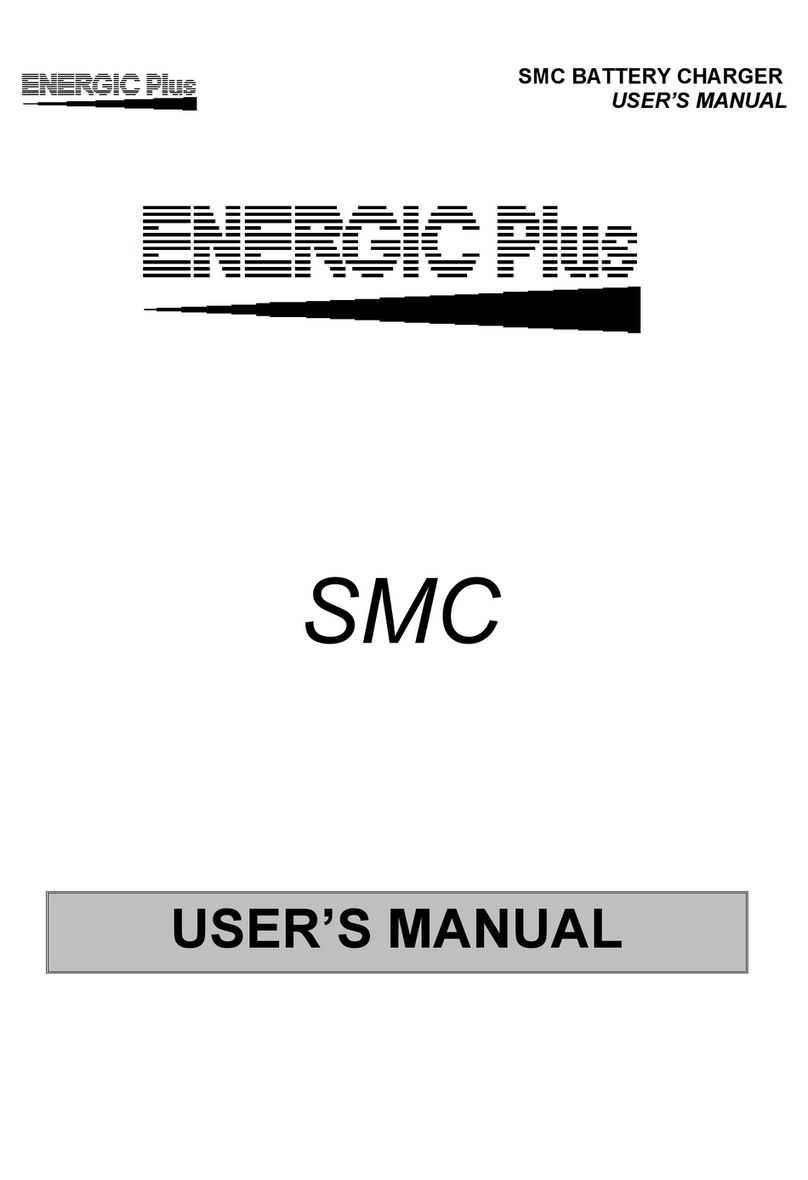
Energic Plus
Energic Plus SMC User manual
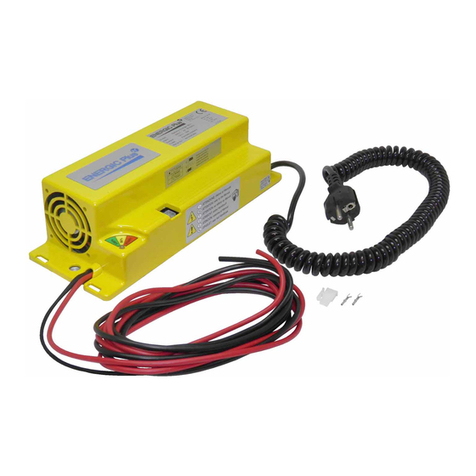
Energic Plus
Energic Plus BC1 User manual
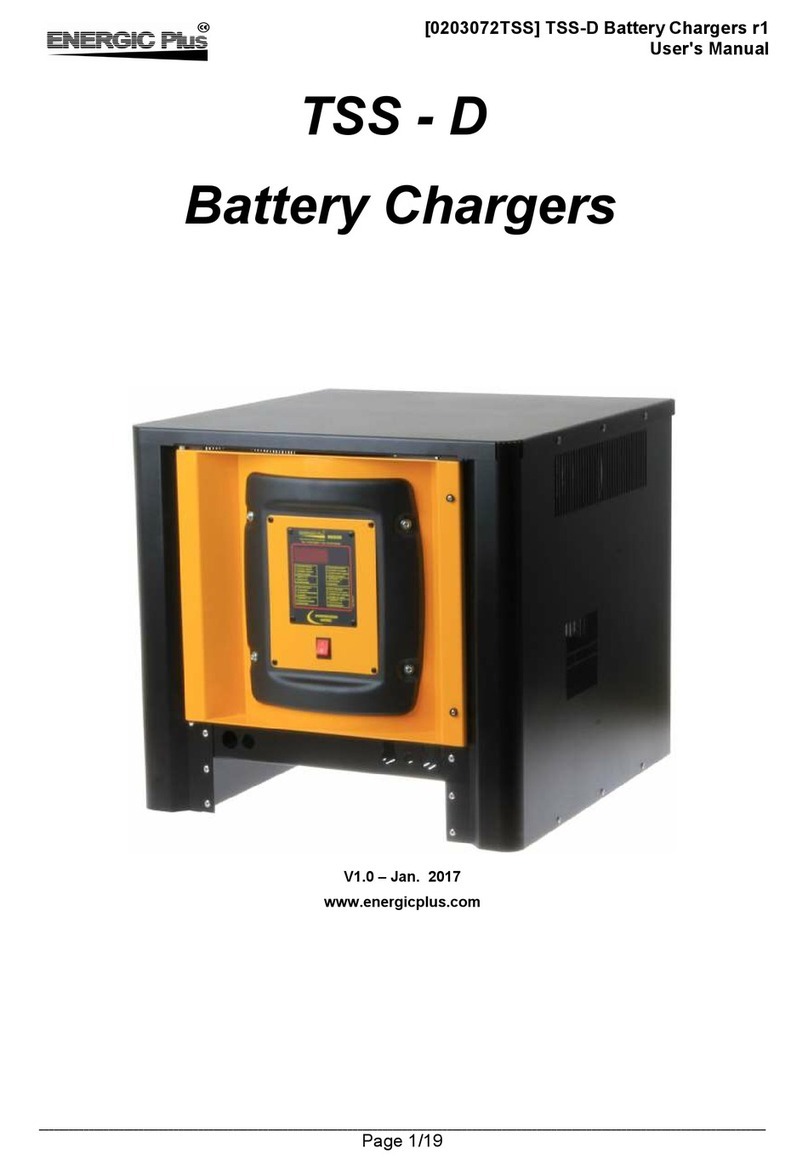
Energic Plus
Energic Plus TSS-D User manual

Energic Plus
Energic Plus RX User manual
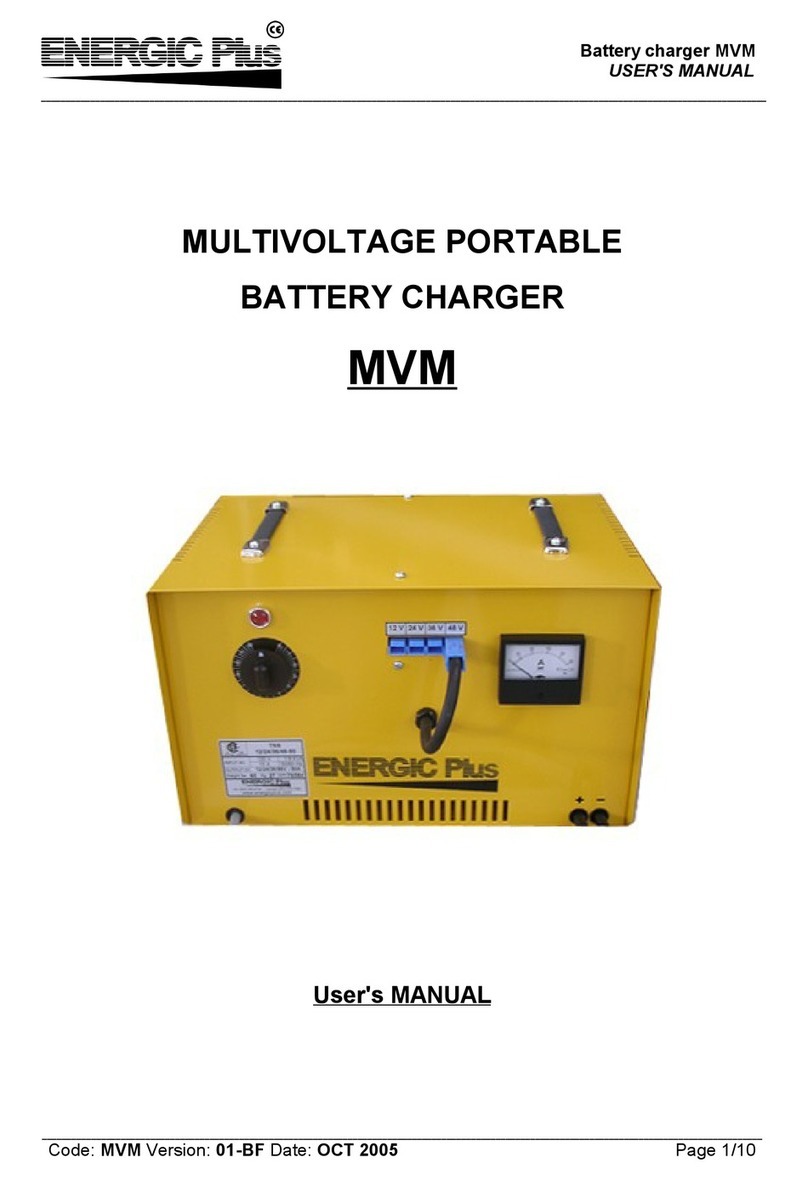
Energic Plus
Energic Plus MVM User manual
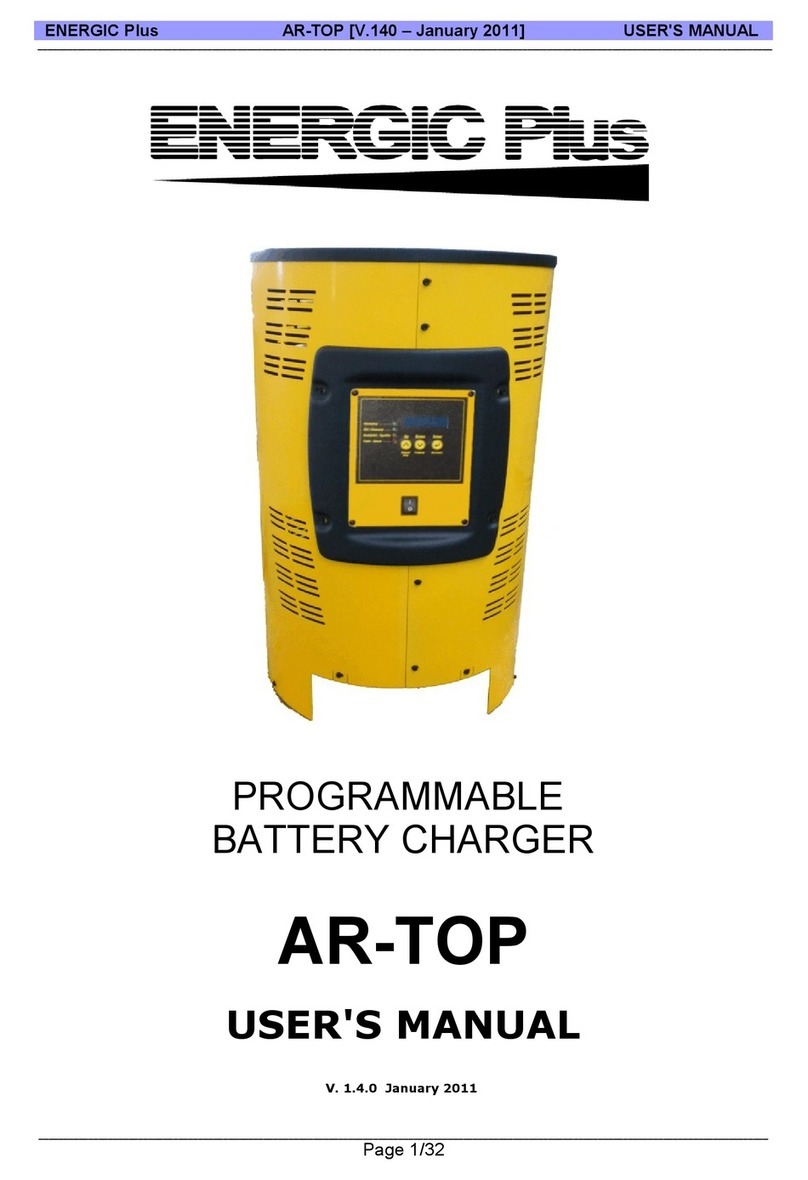
Energic Plus
Energic Plus AR-TOP User manual
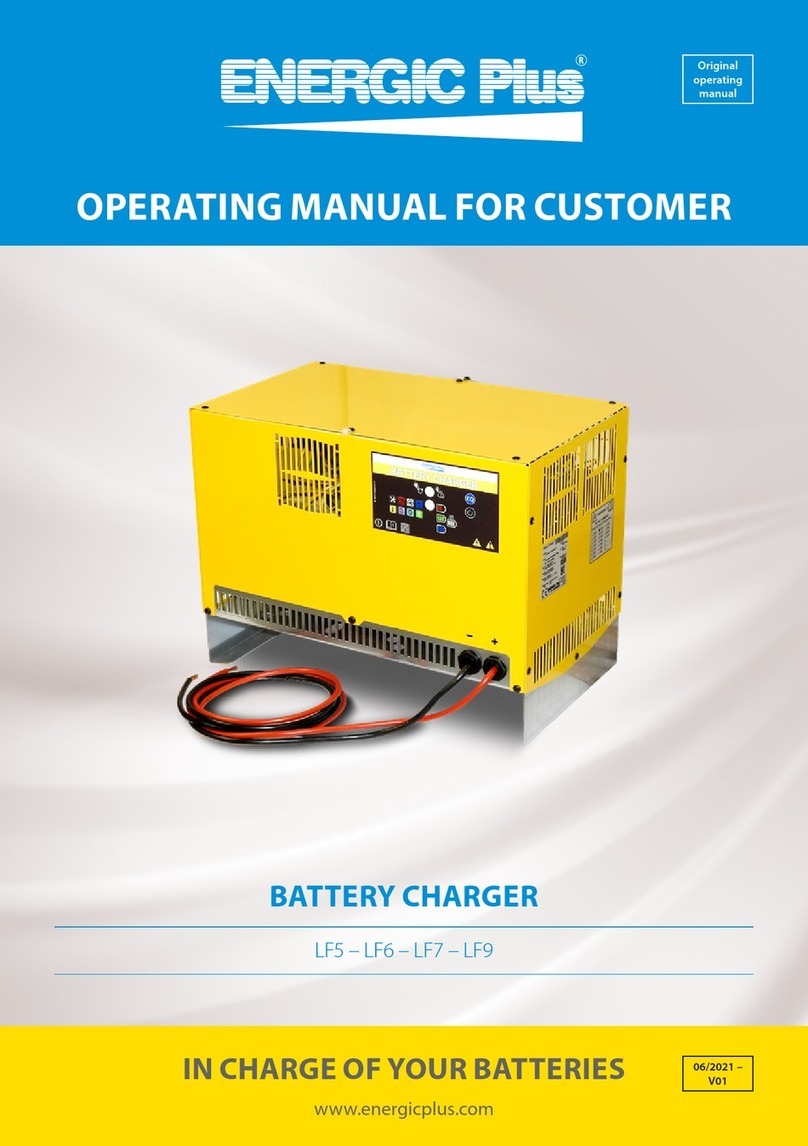
Energic Plus
Energic Plus LF5 User manual
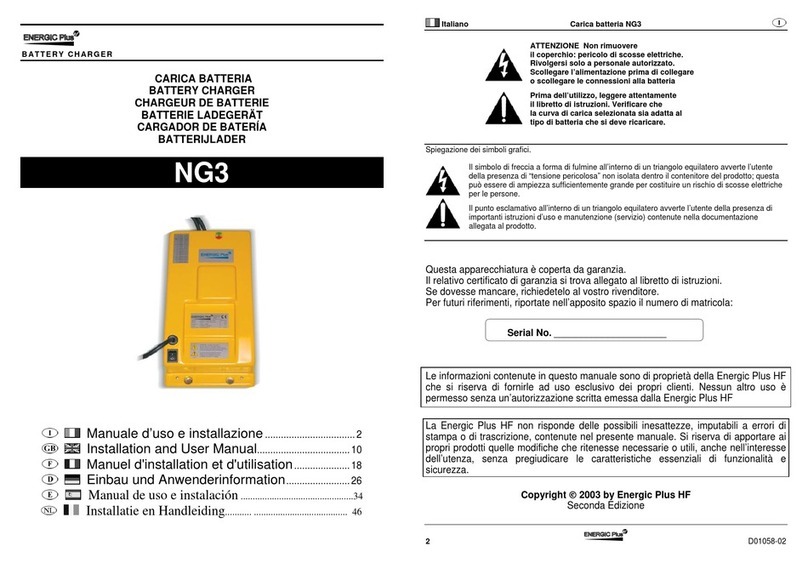
Energic Plus
Energic Plus NG3 User manual
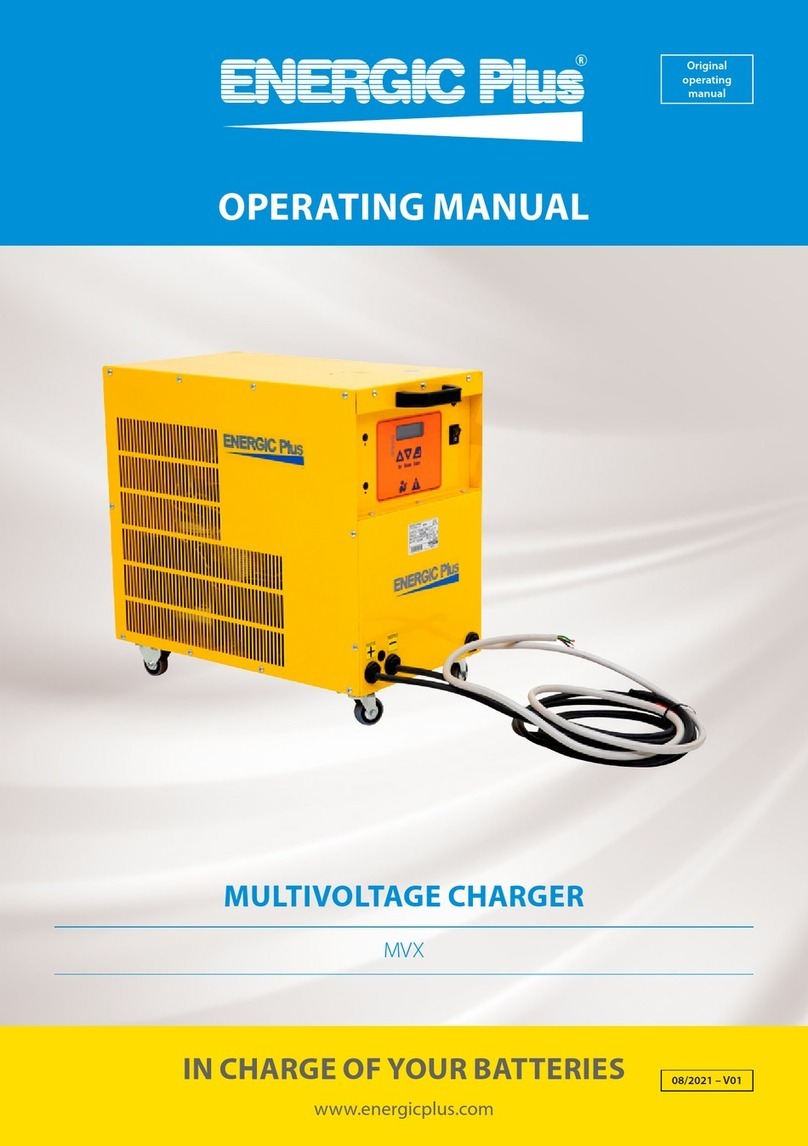
Energic Plus
Energic Plus MVX User manual
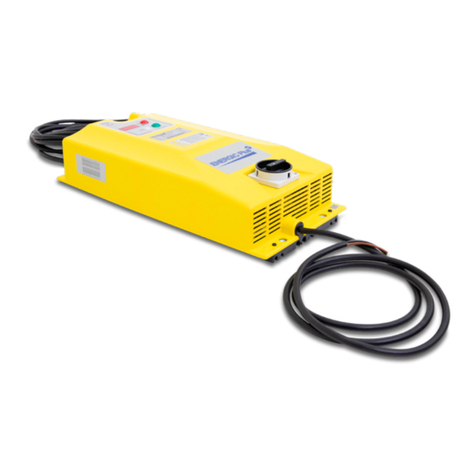
Energic Plus
Energic Plus NG1 User manual

